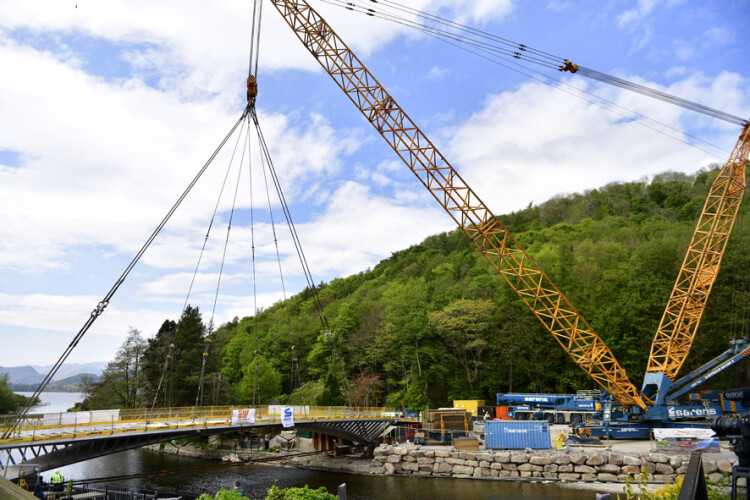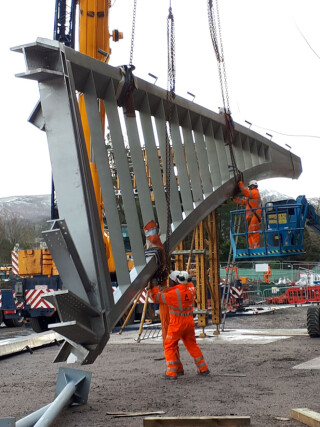For residents of the small Cumbrian village of Pooley Bridge, the waiting is nearly over. December this year will mark the fifth anniversary of the devastating floods that swept away the Grade II listed bridge from which the settlement takes its name. Locals are looking forward to being permanently linked once more by a bridge that lives up to the grandeur of that which was lost.
When Storm Desmond swept across the north west of England in December 2015, it crippled Cumbria – Pooley Bridge over the River Eamont at the north end of Ullswater in the Lake District National Park was just one of 784 bridges that were lost or put out of use as a result of the storm. The three-span masonry arch bridge, which had been standing since 1764, was totally destroyed in the one-in-435-year flood event, and its loss caused considerable shock.
The road to replacement has been a long one, and has involved several intermediate stages, including an extensive stakeholder engagement process to develop a design for the replacement crossing that is now (at the time of writing) nearing completion.
This article was first published in the June 2020 issue of The Construction Index Magazine. Sign up online.
The immediate priority after the old bridge was swept away was to get a temporary link in place and avoid the 16km detour that was required to get from one side of the river to the other. Cumbria County Council appointed consultant Mott MacDonald to take on the task of assessing and managing the infrastructure reinstatement and repair programme across the whole region, including preparing the initial bid for funding from the Department for Transport.
The four-year-long Infrastructure Recovery Programme had a budget of £124m and comprised more than 1,200 works items from small repairs to full reconstruction of roads, retaining walls and bridges.
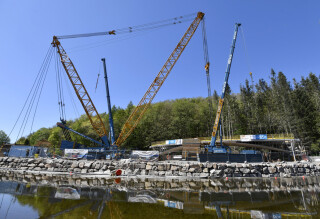
“The whole bridge was lost to scour,” recalls Craig Mitchell, Cumbria County Council’s project manager for the bridge, “and the first thing we had to do was put a temporary bridge in place to reopen the road.” This was done in March 2016, three months after the storm, and the 45m-span truss bridge that was installed remained in use until construction of its permanent replacement commenced last year.
Developing the new design was a complex process with many stakeholders having an interest. But as Mitchell explains, where Historic England would formerly have been one of these parties, the total loss of the bridge changed that.
“If the bridge had been repairable, Historic England would have been advising on the repair of the Grade II listed structure,” he says. “But with the bridge gone, so was any tangible reason for it being listed.” By contrast, the listed Brougham Bridge near Penrith, which was also damaged in the storm, was still able to be rebuilt (see box). A lot of stone masonry was recut to enable it to be reconstructed faithfully, adds Mitchell.
At Pooley Bridge, where the loss of the bridge had shocked the community deeply, it was fitting that local residents should be closely involved, alongside other stakeholders, in the development of a concept design for its replacement.
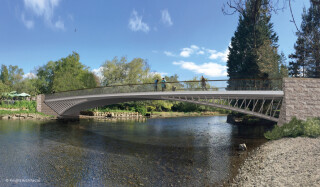
Knight Architects was appointed by the council in 2017 to carry out stakeholder engagement and produce the concept design. “The first task was simply to gather input and comments from stakeholders so that we could identify what they missed about the old bridge, and what their aspirations were for its replacement,” explains bridge specialist and Kinght Architects associate, Héctor Beade-Pereda.
This involved sifting through feedback from more than 100 stakeholders, most of them individuals, in order to establish the main themes around which to build concept designs. This initial engagement did not involve any sketches or ideas – deliberately so, in order to avoid influencing responses and setting any expectations.
Beade-Pereda notes that, compared with most community engagement exercises of this kind, Pooley Bridge involved an unusually large percentage of the local population. “Basically, the community in Pooley Bridge is quite small, so every time we held a public meeting, we had a significant proportion of them present,” he recalls.
“We wanted to find out what their expectations were,” he says, “to find out what they wanted from the new bridge, what it was they missed about the old bridge that was not present in the temporary bridge, and so on. This gave us a good indication of the concerns of the villagers.
“Some of them wanted something that was really innovative, and could be a tourist attraction in itself, while others were concerned about too much modernity and a possible clash between the new bridge and tradition.”
The importance of designing a bridge that could survive floods – and not block the river – was noted in the feedback, so a single-span crossing was key. The consultation also identified ‘lightness’ and ‘transparency’ as among the most desirable characteristics in the replacement bridge; and this was interpreted to mean a slender and minimal structure. Having something that was in keeping with the site, and yet distinctive enough to attract attention, was another noted aspiration.
After digesting the feedback from the consultation process, the team’s next task was to present three distinct concepts and, again, invite feedback from stakeholders. The concepts were all quite different but each one met the key aspirations. One was a suspension bridge, its form quite different from that of the old bridge but still a historic type of structure; the second was a single arch bridge, probably the closest in appearance to the old bridge but with a single span to improve its flood behaviour, and the third was a more modern version of the arch bridge but with open spandrels. “Basically, we wanted to test these concepts,” says Beade-Pereda, “and explore what it was that people liked and disliked about them.”
Detailed feedback was used to develop and inform the final design – for example by incorporating stone-clad abutments, and by refining the structure of the ‘modern’ option to reference Thomas Telford’s classic arch bridge at Craigellachie in Scotland. The final design also retains the single highway lane of its predecessor, but with more space for pedestrians – another key requirement of many of the stakeholders, according to Beade-Pereda.
Contractor Eric Wright Group was appointed to deliver the design & build contract through the council’s framework scheme and Knight Architects remained on the project to fufil the role of ‘concept guardian’ to ensure that the finished project was faithful to the agreed design.
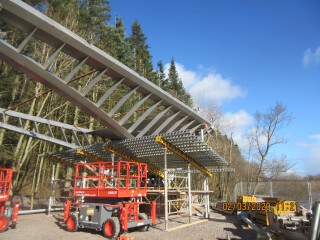
Mitchell recalls that one of the main things that differentiated the winning contractor’s bid was a commitment to work with the concept design, rather than try to change it. “At the presentation stage we were hearing other bidders saying that the design would be difficult, and suggesting how it could be changed. By contrast, Eric Wright Group was coming up with ways to make the design work,” says Mitchell.
The chosen concept is essentially a bowstring arch with a top tie; a design that is similar in its structural behaviour to a half-through arch, says Beade. It is a composite structure, with both deck and arch formed of concrete slabs, connected at their edges to a stainless-steel structure with spandrel columns at right angles to the axis of the arch.
The arch and the deck become a single unit over the middle third of the bridge, and this, combined with the wider deck at midspan, creates the structure’s elegant geometry. At the centre of the span, the edge of the structure is only 600mm deep and at the ends of the bridge this increases to 3.1m.
The stainless-steel shear studs that connect the concrete deck to the steel structure to make it a composite were specially made by the steel fabricator. “We could have ordered them from a supplier in the US,” says Mitchell, “but it would have taken too long to import them.”
Duplex stainless steel was selected not just for durability and maintenance reasons, but also because its strength-to-weight ratio enabled a lighter structure that could be lifted into place as a single piece.

Construction of the bridge was always going to be a challenge, given that the team has had to address conflicting requirements from stakeholders and consider construction risk for the contractor. The ideal construction period from the contractor’s point of view would be June to September, says Mitchell, but this would be far from ideal for a village that relies heavily on summer tourism.
Similarly, with Environment Agency approvals needed for any work in and over the watercourse, the key to success on this score has been to minimise such operations as far as possible. With the lighter structure enabling a single lift, the only operation planned to take place over the watercourse is the pouring of the upper concrete deck.
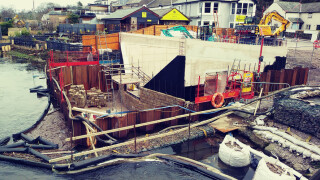
The design-build contract was let in March 2018 with Eric Wright Group and GHD as the contractor’s designer; detailed design was completed in February last year and construction began in May 2019 with site establishment.
The site compound has taken over an existing car park, so the first task was to build a new, temporary, car park to replace it. No work could commence in the river until June, when the risk of flooding had subsided; rock armour was then installed in the river but the main bridge construction had to wait until after the tourist season. In September, the temporary highway bridge was finally removed and replaced by a footbridge to keep the two sides connected throughout the remaining construction.
Cofferdams were built on each side of the river for excavation to a depth of approximately 6m for abutment construction. The abutments are essentially concrete boxes, on pad foundations, within which the backspan frames are housed. Although its outward appearance is a single arch span, the bridge in fact has 2m-long backspans at either end with a complex arrangement of bearings to facilitate its articulation. The abutments will be clad in local stone, in keeping with their surroundings.
Steel fabrication by subcontractor WEC Group began in August 2019 and the 40m-long steel skeleton was brought to site in four pieces, the first two of which arrived in January this year, with the second delivery in February. The span was assembled on temporary supports alongside the river over three months and the first concrete pour to form the arch took place in April. The concrete needed around four weeks to reach its full strength before WEC Group returned to site to fix the steel trays for the upper deck.
The climax of the project was the main lift in early May 2020, when the 320-tonne bridge deck was lifted into its permanent location in one piece. With a load of this size and weight, the choice of suitable cranage is severely limited; Eric Wright ended up with one of the UK’s most powerful machines, a Gottwald AK 680-3 lattice-boom mobile crane supplied by specialist hirer Sarens.
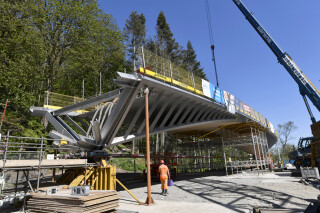
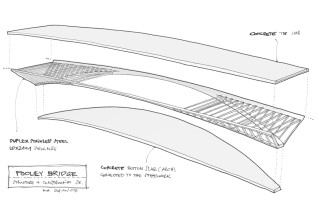
Because the bridge was installed in one piece, the operation could be completed in just one day. In addition to the big Gottwald, Sarens also supplied two telescopic Tadano mobiles – an ATF110 and an ATF400 – to support the rigging process and load out the Gottwald’s two ballast trays, one with 650 tonnes of counterweight, the other with 350 tonnes. These two ancillary cranes, at 110 tonnes and 400 tonnes capacity respectively, are themselves no lightweights.
Although Eric Wright has managed to maintain progress through the Covid-19 restrictions, despite having to stop work for a period while social distancing measures were put in place, the ongoing lockdown meant that the dramatic lift was not the public spectacle that was originally envisaged. At the end of April, the council announced the imminent installation, but warned that public viewing areas would not be provided, and marshals would be present on site during the lift to prevent crowds gathering.
Instead, the council broadcast a live-stream of the lift online and it plans to publish regular updates on its website and social media platforms.
The target date for opening the new bridge to traffic was originally scheduled for the end of June, with the intention of having access fully restored for the 2020 tourism season. But as Mitchell wryly observes, the current situation might render this deadline pointless if restrictions on movement continue.
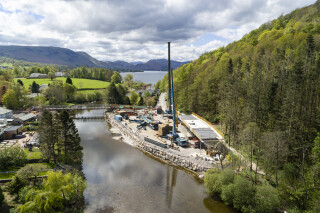
Restoration option for Brougham
Storm Desmond hit Cumbria especially hard in December 2015, causing widespread damage to the road network and isolating several rural districts.
Hundreds of bridges were damaged and although Pooley Bridge was completely destroyed, most of the others were quickly repaired and returned to service.
For Brougham Old Bridge near Penrith, just six miles from Pooley Bridge, it was touch and go. The damage was so bad that it was initially thought likely that the structure would suffer total collapse.
However, subsequent inspections indicated that the Grade II listed bridge could be saved – if the local authority acted quickly. Hence in early 2016, after some meticulous engineering and planning work, the first stage of stabilisation works commenced with the pouring of 110m3 of concrete to fill the main scour hole followed by the reconstruction of the bridge parapets.
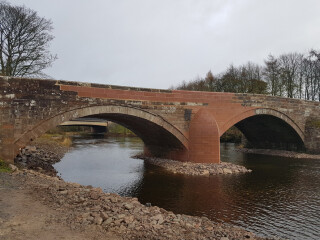
The final phase of repairs began in August 2017 and included reconstruction of the bridge’s main arch and cutwaters and creation of new, resilient, modern substructure. The repairs used a mix of salvaged material from the original bridge where possible, as well as new sandstone from nearby Bowscar Quarry.
The project was designed by Cardiff-based consulting engineer Curtins and delivered by local contractor Metcalfe’s of Penrith. All stonemasonry was carried out by local specialist Cumbrian Stone.
The works cost approximately £750,000 and the restored bridge was re-opened in December 2017.
This article was first published in the June 2020 issue of The Construction Index Magazine
UK readers can have their own copy of the magazine, in real paper, posted through their letterbox each month by taking out an annual subscription. Click for details.
Got a story? Email news@theconstructionindex.co.uk

